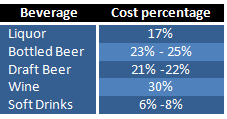Increase Your Profit Series: Part 2 (Accurately Priced Menu)
07 Feb, 2014 | Tags: Bar Promotions, bar scheduling software, Employee Schedule, Employee schedule calendar, employee schedule template, Employee Scheduling, employee scheduling programs, job schedule, Online Scheduling Software, restaurant scheduling software, Scheduling staff members, Shift Scheduling, Staff Scheduling Software
In the conclusion of our 2 part series “Increase your Profits” we are going to review the pricing of your goods, aka your menu. In our last discussion we reviewed that your labor costs should not be more 18% – 24% of your sales. This will need to be monitored closely to ensure you are constantly within your target labor costs. Of course once your sales increase, you will have more customers and need to have a higher number of employees to serve those customers, while balancing this with your target labor cost. But how do you increase the profits on your menu item while maintaining your current level of customers? You can ensure that your menu items are accurately priced to give you the best possible profits.
There are many different theories on how to price menu items and traditionally you look at the food cost for each plate offered, multiple that by 3 and you have your menu price, but this is not the whole story. There are a number of questions you should ask yourself before an accurately priced menu can be truly effective for you.
- Are you storing a large amount of capital in your freezer?
- If a large amount of your money is sitting in your freezer waiting to be sold, your profits can be significantly affected
- Are you offering too large of a selection on your menu causing you to have large inventory levels?
- Evaluate the items on your menu to see what does and doesn’t sell. By removing the low sellers you will not be stocking inventory on those items and regain some of your capital for use in other parts of your business.
- Do you have a regular inventory audit procedure?
- While we never want to think that our staff may be stealing, you need to maintain regular inventory checks to safeguard against theft.
- Are you sure that your staff is following the strict recipes for your food and drinks? (Or do you even have strict recipes?)
- If your bartenders are notorious for over pouring, or if you kitchen staff is increasing the portion size of your plated food, your accurately priced menu means nothing.
Once you have addressed these concerns, you are ready to look at your menu. You want to determine what the exact food cost is for each of your items and then figure out the plate cost. Once you have this information for each of your menu items, you are now able to accurately price these menu items. The plate cost of food should be no more than 29% -32% of your price. Beverage, however are a little different, some involve recipes of multiple items and have a more complex pricing strategy:
What Time Do I Work.com is a simple, easy to use, affordable staff scheduling software that is designed to help you save time and money managing your schedules, so you can focus on other aspects of your business (like an accurately priced menu.) Clients currently using the online scheduling software have found areas where they are overstaffed or scheduling a lot of overtime shifts and have significantly decreased their labor costs. Try it for yourself with our no obligation 30 day free trial!
Increase Your Profit Series: Part 1 (By Simply Managing your Labor Costs)
05 Feb, 2014 | Tags: Bar Promotions, bar scheduling software, conflict free schedules, Employee Schedule, Employee schedule calendar, employee schedule template, Employee Schedules, Employee Scheduling, employee scheduling programs, Employees Schedules, job schedule, Menu, Online Restaurant Scheduling Software, Profit, restaurant schedules, restaurant scheduling software, Schedules
We all know that sales equal profits, but we don’t always think about how much profit we get from each sale. In the restaurant and bar industries there are 3 main costs that can have a significant impact on your profits. The most successful business operators are constantly checking their budget weekly to ensure that they are hitting their target costs to equal the highest amount of profits. These three main sections are food costs, beverage costs and labor costs.
Labor costs can be the trickiest piece of the puzzle to figure out, and unfortunately it usually works out to be about 60% of operations costs. You may think that a standard, repeating schedule each week can help you, but it can be one of the biggest mistakes. Yes, you can save time in creating and communicating your scheduling, but you could be faced with over- and under-staffing. Without adequate staff you are faced with the inability to provide consistent high level service to your customers and if you have too much staff working during a slower shift, you are losing a considerable amount of money. So how do you schedule the right number of staff for each shifts/days/weeks/months?
To accurately calculate the right number of staff on each shift is through reviewing past schedules against shift sales and then forecast your sales for the upcoming weeks/months. On average a good rule of thumb is that your labor cost should not be more than 18% – 24% of the expected sales. Accurate forecasting can take a while to master, but WhatTimeDoIWork.com offers the ability to help you.
WhatTimeDoIWork.com online employee scheduling software was developed by employee schedulers from the restaurant industry. The software saves and stores previous schedules for easy access when comparing to your sales reports and for creating upcoming schedules. A unique feature of WhatTimeDoIWork.com scheduling software is the ability to track and calculate labor costs as you create the schedule, telling you while you make the schedule what your labor costs will be. There are many other great features offered by WhatTimeDoIWork.com online scheduling software to help you save time and money. To learn more try our no obligation 30 free trial today!
The secret to getting new patrons is spelled “F-U-N”
03 Feb, 2014 | Tags: bar schedules, bar scheduling, bar scheduling software, Employee Schedule, Employee schedule calendar, employee schedule template, Employee Schedules, Employee Scheduling, employee scheduling programs, Employee Scheduling Software, online employee scheduling software, Online Scheduling Software, restaurant schedules, restaurant scheduling, restaurant scheduling software, Scheduling Software, Staff Scheduling, Staff Scheduling Software, workforce schedule, Workforce Scheduling
Your restaurant is unique, with a style all its own. You’ve worked hard to create an atmosphere that welcomes patrons to spend some time eating good food, relaxing at the bar with a martini or glass of wine, and enjoying the company of friends.
But you’re well aware that your restaurant is not the only game in town. You vie for patrons with many other establishments in your general area. And while you have a large number of loyal locals, you need to attract new patrons from other areas of town who want to do more than just eat and run—but to eat, drink, and hang out for the evening. This is the best way to ensure your restaurant’s long-term success.
So what do you do to attract more patrons? How about turning part of your bar area into a game area? You can place ads in the local newspapers and online, and hang a funky sign in the doorway that proclaims, “Game Room,” with a hand pointing to the new game zone. While the older crowd might have little interest in pool, younger folks will be delighted to spend their money on pool, darts, cocktails and appetizers—and you’ll be happy with your new patrons and profitable venture.
You can expand on the “fun” theme by adding activities like trivia nights, comedians, musicians and other “bar” games such as darts. Trivia nights are sweeping the nation and bringing large crowds to bars. Many patrons will remember happy days in college, when their on-site bar sponsored a weekly darts league. They’ll fondly reminisce about the Thursday nights they spent with dozens of students and friends, vying for the top spot on the leader board. Like many restaurants, pubs, and bars, your games atmosphere has the potential for huge success—not only in terms of bringing in new clientele, but also in significantly boosting bar revenue.
At the end of the day, you’ll benefit not only from excellent earnings, but also dozens of new and frequent patrons looking for good food, good drinks, and a good time. So the moral of the story is, “To get patrons to spend more time—and money—at your establishment, you don’t have to spend a lot of money—just spend it on things that spell F-U-N.”
Don’t forget that What Time Do I Work.com scheduling software can assign duties and tasks to your staff to ensure that all patrons receive excellent customer service and that you bar is adequately staffed at all times. You can try it out free for 30 days!
How do you create a Time-off Policy
17 Dec, 2013 | Tags: bar scheduling software, conflict free schedules, Employee Schedule, Employee schedule calendar, employee schedule template, Employee Schedules, Employee Scheduling, employee scheduling programs, Employee Scheduling Software, hospital scheduling software, hotel scheduling software, job schedule, Job scheduling, Job Scheduling Software, Medical Scheduling, Medical Scheduling Software, online employee scheduling software, Online Restaurant Scheduling Software, online scheduling program, restaurant schedules, restaurant scheduling software, Retail Scheduling, Scheduling Software, Scheduling tools, Staff Scheduling, Staff Scheduling Software, What Time do I Work, Whattimedoiwork.com, Work Scheduling, Workforce Scheduling
For many companies, managing vacation and time-off requests is a constant challenge. You need to maintain adequate business coverage and support while understanding that your employees have times when they need to take time off. The outcome of not having a formal policy in place about when and how to submit requests results in employees asking for time off by:
- Talking to you in the hallway or your office
- Calling you on the phone
- Sending you an email
- Scribbling the days and dates on a piece of paper and dropping it on your desk
- Taping a note to your office door
These types of requests are not only hard to deal with on the fly, becasue of the no boundaries on “acceptable ways to request time off,” but you are also tasked with trying to keep track of who requested what time off. And if you have two employees requesting the same days off, who gets first dibs?
There are many different options and ways to create policies, but the most common in the service and health industries is to create a “time-off bank.” Here’s how the bank works. Let’s say each employee is allowed 160 hours off each year, which equates to 20 work days. The bank includes time off for:
- Holidays
- Vacation
- Sick days
- Personal days
You can’t always give all your employees all of the holidays off, so they can use their banked time to request vacations or personal/sick days off. Each employee is responsible for scheduling the days he or she wants off from work, using a single prescribed method, within the needs of the business. You can require that requests are submitted for planned time off within 2 weeks of the date, and that they must submit requests on special forms that are filed away for you to refer to when creating upcoming schedules
This plan offers many benefits to employees. They can:
- Ensure that their time off request will not be forgotten
- Assume responsibility for their own time off; they make their own choices, and they need to abide by them. For example, some employees might prefer a day off for religious holidays, rather than the Fourth of July.
- Draw from their time-off bank for emergencies, such as caring for a sick child. Remember, the bank is for all time off—holidays, vacation, sick days, and personal days.
The plan also offers many benefits to you. You will:
- Spend significantly less time managing time-off requests; all requests will come to you through the standard form submitted in the “time-off request box”
- Create more accurate schedules that require fewer changes, as you no longer have to try to remember who asked for what time off?
- Empower your employees by letting them make more choices about how they spend their time away from work
- Create a more positive working atmosphere at your company
All of these ways are great, but they are still time consuming, especially when going through all the requests each time you make the schedule. Wouldn’t it be nice if you had a way for the requests to be waiting for you right on the schedule? How about knowing when each request was submitted so that you can grant requests in a first come first serve method? The solution is available today from WhatTimeDoIWork.com and there are many other benefits far beyond tracking time-off requests and auto-populating them right into the schedule.
- Automatic alerts to scheduling conflicts and overtime hours
- Calculation of Labor costs as the schedule is created
- Posting of the Schedule online allowing employees easy access without picking up the phone
- Communications sent to your entire staff as soon as a new schedule is posted.
We are so sure that our software will solve your scheduling needs that we offer the first 30 days at no charge, with no obligation.
Learn more here.
What are the benefits of Online Employee Scheduling Software vs. the Traditional Methods?
05 Dec, 2013 | Tags: bar scheduling software, conflict free schedules, Employee Schedule, Employee schedule calendar, employee schedule template, Employee Scheduling, Employee Scheduling Software, hospital schedules, How do I create Conflict free schedules, job schedule, Job Scheduling Software, online employee scheduling software, online schedule, Online Scheduling, restaurant schedules, restaurant scheduling software, Schedule, schedule program, Schedules, Scheduling, scheduling best practices, Scheduling Programs, Scheduling Software, Scheduling tools, Staff Scheduling, staff scheduling softrware, web based scheduling software, Web Scheduling Software, What is the best online scheduling software, Why do I need Online scheduling software, Work Scheduler, Work Scheduling, Workforce Scheduling
Mr. Kennedy owns a midsize company called Kennedy Linens2Go, which supplies linens to hospitality businesses in the Boston, Massachusetts, area. The company operates a fleet of trucks that picks up dirty linens and drops off clean ones on a regularly scheduled basis. The principle staff members at Kennedy Linens2Go include truck drivers and linen washers.
During the majority of the year, scheduling the drivers and washers is a relatively quick and easy task. Workers have their preferred hours and shifts, and there are relatively few requests for time off. But in the summertime, workers want time off for vacations at the beach, to travel, and to spend time with their kids. Then during the holidays, people request time off to shop and attend special functions and spend time with friends and family. During these times of the year, Mr. Kennedy spends many hours each week preparing the weekly employee work schedules.
For Mr. Kennedy, creating an employee schedule for a typical pre-holiday week means:
- Accepting time-off requests from the staff via the phone, in his office, notes left on his desk or passing by in the hallway
- Creating a schedule based upon what Mr. Kennedy thought were all the requests
- Getting three last-minute requests from workers who forgot that Monday was the day to submit time-off requests
- Throwing away the original schedule and starting over again
- Finishing the second schedule, only to find that he forgot to include two part-time drivers
- Starting again on schedule number three
- Finally posting the schedule in the employee lunch room only to have one employee complain that they cannot work their scheduled shift after half of the employees have already seen the weekly schedule
- Once again he must start over for draft 4, and then contact all his employees to inform them that a new schedule is available
After two months of pre-holiday scheduling frustration, Mr. Kennedy needs some time off himself.
Rather than a vacation, Mr. Kennedy needs a new way to create weekly employee schedules. He needs a method that is quick and easy during every week of the year, even during the holidays. He also needs a much more efficient way to notify his employees of newly posted shifts and to avoid spending hours on the phone giving each of his employees their upcoming schedule, when they are not working. He needs to stop working in his business and start spending time on his business.
Luckily the perfect solution is available today from WhatTimeDoIWork.com. By offering, simple, flexible, realistic, easy-to-use online employee scheduling software, WhatTimeDoIWork.com enables Mr. Kennedy to store all his employees’ names, departments, skillsets, emails, phone numbers, preferred shifts, and requested time off in one online location. With point-and-click simplicity, Mr. Kennedy can create an employee schedule in minutes. And because all time-off and shift requests are stored in the software, Mr. Kennedy receives an alert when a scheduling conflict appears—such as trying to schedule a part-time driver on a day when she doesn’t work. Schedule changes are just as easy—Mr. Kennedy can simply cut-and-paste a time slot to a new name. Even better, all new schedules and changes are distributed to all staff members via email or smart phone, and remain accessible online to the entire staff 24×7. No more calling his entire staff not only when a new schedule is posted, but if there are any updates to the schedule.
Mr. Kennedy will find numerous benefits from online scheduling software:
- No more keeping notes of when employees want time off
- Ability to manage/update/change a schedule at any time
- No-shows are reduced; schedules are always available to the entire staff, so they all know their shifts
- No more paper schedules are required
- Employees can find their own replacements to cover in an emergency—removing Mr. Kennedy from the equation
- Automatic alerts of overtime hours or scheduling conflicts while creating the original employee schedule, which will cut down labor costs
- View labor dollars as the schedule is created
- Remind employees of upcoming shifts to eliminate no shows
To sign up for online employee scheduling software, Mr. Kennedy can simply visit https://www.whattimedoiwork.com/free-trial/. He can discover for himself how much time, effort, and frustration he’ll save by moving his employee work schedules online.
Try it out today with our 30 day no obligation free trial. And when we say free we mean free:
- No credit card is necessary to try the software
- No service contracts or hidden fees
- No downloads required





